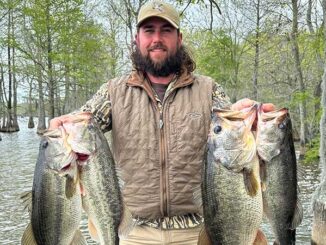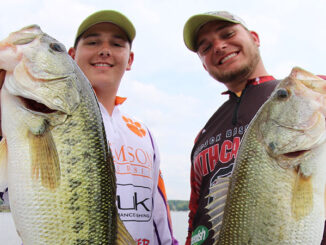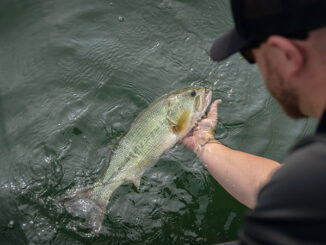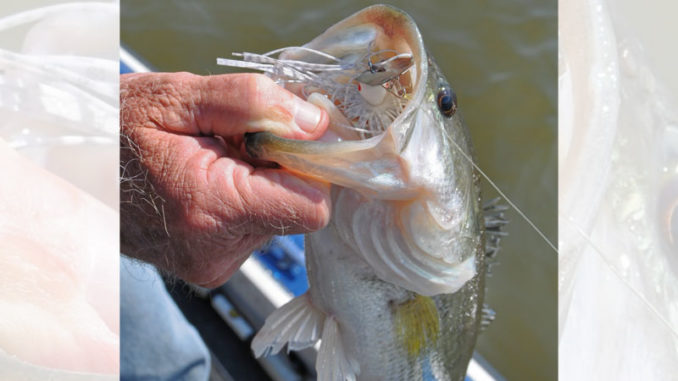
Mining the shoreline grass at North Carolina’s Falls of Neuse Lake this month is a great way to get your string stretched by a bragging-sized bass.
The small cove off Falls of the Neuse Lake’s main body was a foot or two deep around its edges, and the water was murky in early April 2018.
Aquatic vegetation covered the surface, extending from 4 to 12 feet from the shoreline.
“Bass should be (shallow) this month,” said guide Kennon Brown of Roxboro, N.C.
As he spoke, he spied a tail fin, as wide as a man’s spread-open hand, waving in the air. A female largemouth bass was nose-down, clearing debris from the bottom at a place she’d chosen to lay her eggs.
“Look!,” said Brown, 71, of Hawg Hunter Guide Service. “It’ll make your heart thump a little harder when you see a fish like that, but I don’t know if we can get her interested in a lure.”
We estimated the fish at around 10 pounds — maybe more — because of the size of that fin. That’s no small fish at Falls, a river-fed 12,500-acre lake north of Raleigh and Durham that boasts a lake-record fish of a few ounces more than 13 pounds.
Unfortunately, Brown was correct. The female ignored lures for 15 minutes. Finally a shadow from Brown’s bass boat spooked her; she quickly dove and swam away
“It’s not too unusual,” he said. “A female sets her mind on clearing a bed, and she’s not going to be distracted. But she’ll come back. A few more weeks with the right water temperature, and this will be a place where I’ll be, too.
“When they’re laying eggs, a bass will hang around her nest. If anything comes near, like a soft-plastic bait, she might pick it up and move it away. That’s the time for sight-fishing, if the water’s clear enough so you can see ’em. Sometimes, if you can get her mad enough, she’ll whack it.”
During spring, female largemouths create beds and spawn at different times on Falls. Other fish may be in a prespawn mode, in a mood to eat before they begin to bed. If they haven’t moved shallow, bass often stage in 5 to 12 feet of water, and they will be susceptible to lures.
“There’s always male bass, too,” Brown said. “They’re gonna be near females. After she leaves, they’ll guard a nest and really thump lures, especially ones that look like salamanders.
“They won’t be as large as the females, but they’ll usually be hungry and smack lures, whether from hunger or simply their instinct to guard nests against intruders.”
Grass invasion
Although Falls Lake didn’t have a lot of submerged aquatic vegetation for years after its impoundment in 1981 by the U.S. Army Corps of Engineers, some shoreline grass began to appear.
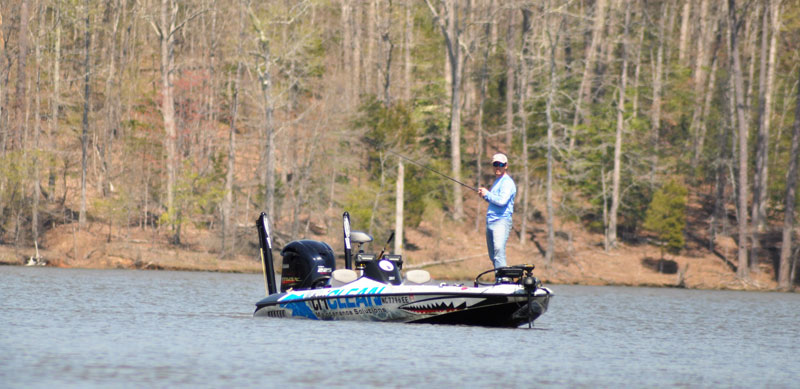
“Duck weed and eel grass began showing up three or four years ago, and now it’s just starting to thrive,” Brown said, “but only some parts of the lake have got it. Boats, boat trailers and birds probably transported it from other lakes to Falls, especially from Harris or Mayo.
“It’s really good for bass fishing because it puts plenty of oxygen in the water. It also is a good hiding for baitfish, especially in the summer, because of the shade it creates.”
Bass begin to move into the patches of duck weed and eel grass in February, Brown said.
“The second or third week of March is the prespawn here, but it starts close to the dam,” Brown said. “The spawn moves up the lake to the center part. You’d think it’d move from the (upper) parts where the water is shallower and warms up quicker, but it doesn’t at this lake.”
Just floating along
Brown prefers a 7-foot, Lews Custom Speed Stick rod mated to a Lews LS5 baitcasting reel spooled with 12-pound P-line fluorocarbon.
“It’s sinking line, because monofilament floats when you don’t use any weight,” said Brown, because it allows him to fish his favorite spring bass lure — a floating worm — across the top of grass mat on the surface or drop down into holes in the grass.
“I look for two things: tailing’ fish or holes in the grass,” said Brown, who fishes a floating worm weightless on a 3/0 Trokar hook with a swivel in front of 12 inches of fluorocarbon leader to keep line twist at bay.
“Floating worms have great action and apparently look like small snakes or night crawlers to bass,” Brown said.
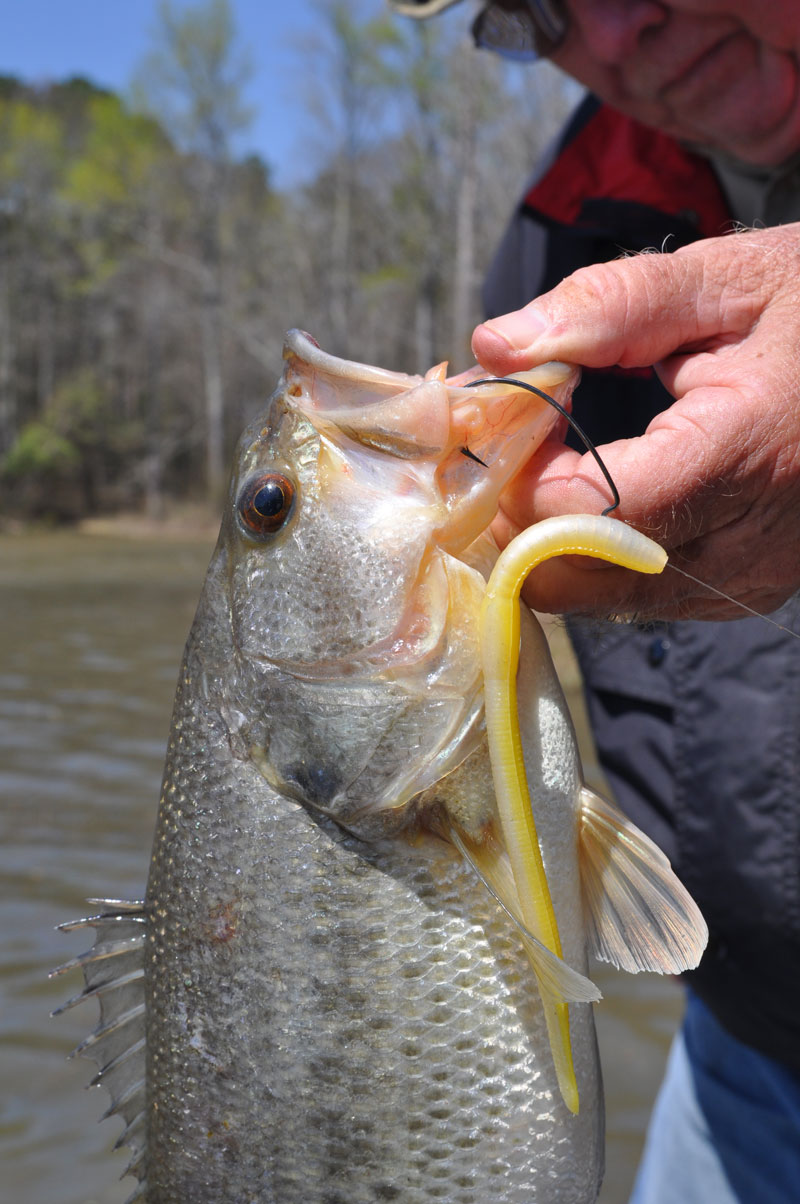
One oddity about spring largemouths in North Carolina lakes is they prefer brightly colored floating worms, including pink, yellow and white. Although day-glo colors aren’t natural in the outdoors, they apparently grab the attention of bass — along with their twisting, spinning movements — as they’re retrieved.
“The best retrieve is a slow one,” Brown said. “You can move them across the tops of grass a small rod-tip twitch at a time, then, if you pull it across a hole in the grass, just let it fall toward the bottom. You don’t have to do anything to a floating worm; they’ll wiggle on their own as they sink.”
In order to avoid hang-ups, anglers may rig these lures two ways:
- Pushing the hook’s barb through the top quarter-inch of a worm, then through the body until it slightly breaks the skin on one side. Next push the worm’s body to cover the barb. The worm must hang vertically to work correctly.
- Hooking the barb into the side of the worm, barely concealing its tip under the “skin” on one side.
In these weedless setups, when a bass strikes, the barb should easily come through the worm’s body or side and stick in a fish’s mouth when an angler jerks his rod tip.
But spring bass attacks vary.
“You have to be aware of light taps on your line,” Brown said. “Sometimes, a bass sucks a plastic worm into his mouth, and you’ll see your line twitch and feel a slight ‘tick’. Other times, you might not feel anything, but you’ll see your line moving off because slack can keep you from feeling a bass’s weight. That’s when you have to reel in line until you feel him. Then you jerk his jaws.
“Other times, a fish will just blast a lure, and there won’t be any doubt what’s happened.”
She’s on the line
One key to success when fishing vegetation is line watching.
“When I find a large hole in grass, I’ll cast as far towards the bank as I can, behind the opening, and move the worm slowly toward the opening,” Brown said. “When the lure starts to drop toward the bottom, that’s when a bass may suck it into its mouth. You’ll often see the line make a small twitch. But don’t jerk the line then. You should raise your rod tip fast, but not hard, to see if you can feel the fish’s weight. If you feel him, then set the hook.
“If nothing’s there, I’ll lower the rod tip again and let the worm fall to the bottom. This type of fishing requires a lot of patience, because it’s not fast fishing. If I get the worm back to the surface, I’ll start the retrieve again.”
Anglers who fish Falls of the Neuse, which stretches 28 miles from the dam in Wake County to the outskirts of Durham at the I-85 bridge, know the lake fishes in three distinct sections. Falls lake has a narrow, curvy lower section that resembles a moderately deep river with steep sides; an open middle portion with large feeder creeks from the NC 50 bridge to I-85, and a super-shallow flats habitat upstream of I-85.
“You can find shallow places in the lower (portion) of Falls,” Brown said. “They include little coves and flats that might have pea gravel, sand bottoms or rocks, and all have bass beds.”
Many anglers choose suspending jerkbaits in late March and early April because bass will stage near spawning areas until the water temperature rises to between 62 and 70 degrees.
The spawn can be two weeks apart between the lower and upper sections of the lake.
“But the central part of the lake is where I do most of my fishing,” said Brown, who loves to find said.
Bass and willows
His favorite place to find shallow bass is Ledge Creek. Its upper end contains several acres of shallow water filled with willow bushes; bass like to beds in the roots of the willows. The back of Lick Creek also has dozens of willow trees in shallow water, plus flats with submerged grass.
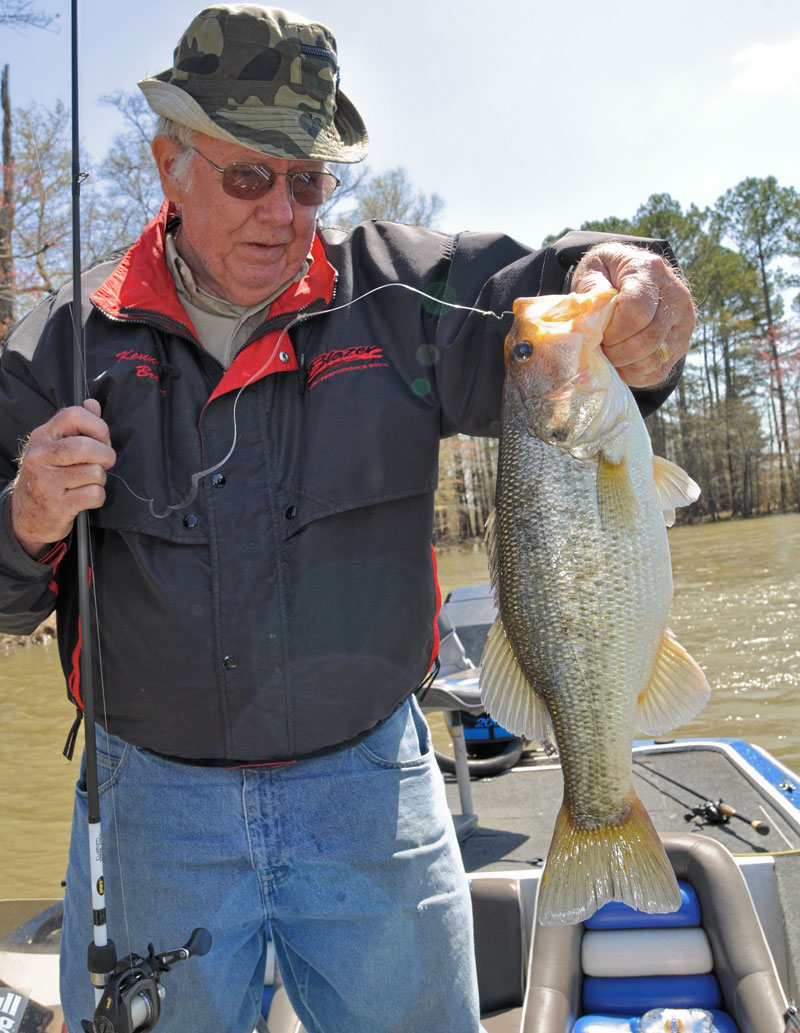
Little Lick Creek, west of Rollingview Recreation area, also has grass and trees in its back section. Underwater vegetation, in fact, covers half the creek.
Grass and stumps line the shoreline of the upper portion of the lake from the mouth of Little Lick Creek northwest beneath Old Weaver Road to the I-85 Bridge and beyond.
“But you might have to move around to find bass that’ll chase a lure,” Brown said. “Depending on where you’re at, you might be finding prespawn, bedding or postspawn fish.
“For most people, prespawn and postspawn are the best times because when bass are spawning, they aren’t thinking about eating. If a spawner hits a lure, it’s usually a reaction strike to anything in their nest area. The males do reaction strikes, too, but they don’t lose their appetites like females.”
The reason Brown fishes certain coves and creeks at the lake’s midsection is the sun’s angle. Rising is the southeast, on sunny days its rays bathe the northwest shoreline longer than anywhere else. That heat draws baitfish, encourages aquatic vegetation to grow, puts oxygen in the water and draws bass.
“But on cloudy days, after a few sunny days and if the wind’s from the southeast, it’ll push warm surface water to northwest banks,” he said.
The most-recent study by the N.C. Wildlife Resources Commission revealed that half of Falls of Neuse bass were 14 inches long, while 20 percent were longer than 16 inches. The agency’s biologists noted that Falls of the Neuse has a healthy largemouth population with good age and size distributions.
“I’ve caught 17 (bass) over 10 pounds from Falls Lake,” Brown said, “but I sure would like to hook up with one of those tailing fish. You can bet I’ll be back here soon, trying to get one of them.”
DESTINATION INFORMATION
- HOW TO GET THERE — Falls of the Neuse Lake is north of Durham and west of Raleigh. I- 85 crosses the upper end of the lake, NC 50 crosses at mid-lake. Public boat access areas are scattered along the shoreline, with Hickory Hill just south of I-85, Ledge Rock in Ledge Creek downstream from I-85, NC 50 and Upper Barton Creek in mid-lake.
- WHEN TO GO — Late March through April is the time to be on Falls of Neuse Lake, as bass move from prespawn through the spawn in different parts of the lake.
- BEST TECHNIQUES — Fish a floating worm, weightless and weedless, around shallow grass and willow bushes.
- FISHING INFO/GUIDES — Kennon Brown, Hawg Hunter Guide Service, 919-358-3207, www.hawghunt.com; Rollingview Marina, 919-596-2194. See also Guides & Charters in Classifieds.
- ACCOMMODATIONS — The Inn at Creedmoor, Creedmoor, 919-529-2034; Quality Inn & Suites, Creedmoor, 919-575-6565; Sleep Inn, Wake Forest, 919-556-4007. Falls of Neuse State Recreationa area (877-722-6762) and Rollingview Recreation Area (919-676-1027) offer camping.
- MAPS — Fishing Hot Spots, 800-255-6277, www.fishinghotspots.com.

